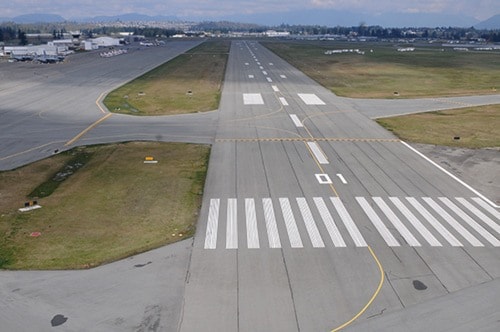A new poll shows half of Lower Mainland air travellers recently drove to the U.S. to catch a cheaper flight instead of using a B.C. airport.
The Insights West online survey found 51 per cent of respondents who flew anywhere in the last two years did so at least once by driving across the border to airports such as Bellingham or Seattle.
"It was more than I expected," said Insights West senior vice-president Catherine Dawson.
Mike Pastro, general manager of the Abbotsford International Airport, said the number from the Insights West survey seems high, though border-crossers are a concern for the airport. Pastro said he has heard other statistics about border-crossing for flyers, such as 20 per cent of Lower Mainlanders drive to the U.S. for flights, and that 50 per cent of passengers flying from the Bellingham, Wash. airport are Canadians. He said this is a concern for all Canadian airports located near an airport across the U.S. border.
"It does have an impact… up to as many as 100,000, possibly more, passengers per year are flying from Bellingham and Seattle, who would have otherwise flown from Abbotsford."
Jay Teichroeb, the city's general manger of economic development, said an economic impact study found that the airport generates about $610 million for the city annually, both directly and indirectly. Though the city has not examined the economic loss caused by travellers flying out of the U.S., Teichroeb said losing 90,000 to 100,000 passengers to the Bellingham airport does have an impact.
"It's a big issue.. it's certainly an issue of significant importance to the city of Abbotsford, not just to the airport business, but our retail sector is impacted too."
Dawson said the trend seems to be growing, with 23 per cent saying they cross the line more often to fly now than they did three years ago, compared to six per cent who said they do it less often.
Lower prices offered out of U.S. airports were the overwhelming reason, listed as an important factor by 97 per cent of those polled, far ahead of considerations like airline preference, ease of border crossing, or whether they have friends or family across the line where they can stay or park their car.
Pastro agreed that the core of the problem is high Canadian airfares. He said in Canada the base airline fare starts higher, due to the U.S. having more competition and possibly paying lower wages. On top of that, Pastro said, Canada has more fees and charges, such as air traveller's security charge and fees to NAV CANADA for the air traffic management services.
"It's not really a level playing field, because in the United States the airlines don't have to pay a lot of the fees and charges that they have to pay in Canada."
Pastro said that in Canada, flyers pay an airport improvement fee which helps pay for upgrades to infrastructure, saying its a "user-pay approach." He said that in the U.S., these improvements are subsidized by the government.
Dawson said the 49 per cent who stuck to Canadian airports would include some who didn't have a choice because they were flying to smaller B.C. towns not served by U.S. airports.
Had those been factored out, she said, it might well be that a clear majority of Lower Mainland flyers with an option to fly via a U.S. airport are making that choice.
The poll found most Metro Vancouver and Fraser Valley flyers using U.S. airports were heading to U.S. destinations, while 19 per cent were bound for other international cities.
The Abbotsford Airport does not offer flights into the U.S., which Pastro said is largely due to the cheaper flights that are already available in the U.S. Though the airport hopes to be able to offer those flights in the future, a low-cost carrier is needed.
One finding Dawson called "very surprising" is that seven per cent were crossing the line to take short flights of less than three hours to Canadian destinations and six per cent were taking longer flights back into Canada.
Dawson said the cost of flights is the "prime motivator" and air travellers polled were quick to blame both the airlines and the federal government but not themselves for using U.S. carriers.
Fully 97 per cent agreed (72 per cent strongly) that Canadian airlines need to improve their pricing if they want to prevent Canadians from driving to U.S. airports. They also cited higher taxes and fees adding to Canadian ticket prices.
Dawson doubted whether that majority view is logical.
"Is the Canadian air industry ever going to be competitive in the way U.S. airlines are? I'm not sure they can. It sort of calls into question whether Canadians are being realistic or not."
Pastro said the Abbotsford Airport tries to overcome the price issue by controlling what they can – keeping their airport fees and charges as low as possible. He said Abbotsford has among the lowest fees in Canada, some of the cheapest parking fares, and it is an easy-to-use, low-hassle airport.
"What we do in order to be competitive and to combat the cost issue is to be the lowest-priced airport that we can be."
Insights West surveyed 450 Metro Vancouver and Fraser Valley residents, and focused on the 77 per cent of local residents who took a flight of any kind in the last two years. For more details see www.insightswest.com.
The findings come on the heels of a February poll on cross-border shopping trends that found a large majority of the Lower Mainland's residents regularly shop in the U.S.
